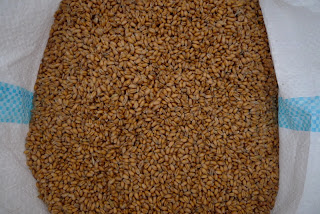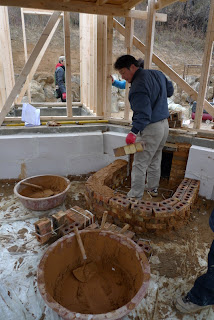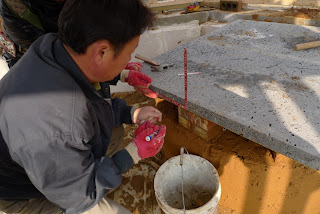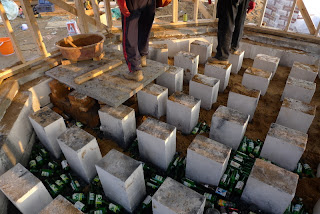2001-2002年に和歌山県橋本自然農苑で研修を受けたときに不耕起栽培でサツマイモを作りました。橋本さんは、福岡さんの稲と穀物の不耕起栽培を成功させた大阪の農家さんからアイディアを得て、さらにはペンシルバニア州のRodale Instituteという有機栽培を研究している機関と同じ栽培方法で、ライ麦とヘアリーベッチのマルチでサトイモとカボチャを作りました。ライ麦とヘアリーベッチの花が咲くと倒す。咲く前に倒すと、また立っちゃう。遅すぎると、ヘアリーベッチの根に存在しているバクテリアが固定した窒素が種を作るため使用されてしまいます。
In 2005-2006, I used this method while managing the organic market garden at Slippery Rock University's Robert A. Macoskey Center for Sustainable Systems Research and Education. Basically winter rye and wheat were crimped to provide a mulch for tomatoes. I remember that the wheat alone did not provide enough much and needed to re-enforcement with additional mulch.
2005-2006年に大学院生のときにマーケット・ガーデンを担当した際、ライ麦のマルチでトマトを作りました。うまくいかなくて、雑草を押さえられなかったです。
Unlike the systems described above, the system described below harvests the grain of the cover crop, in this case winter wheat. Since I did this by hand, it might not be adaptable to a commercial system. A very rough calculation of time and yield harvesting wheat in this manner is 10-15m2/hour/person which yields maybe 2-5kg after threshing. After harvesting the wheat ears still need to be threshed and can be done with a stationary harvester after drying.
今回はRodale Instituteのやり方と違う方法で穀物を収穫します。手で収穫しますので、大規模なものには向きません。大体一人が1時間に10-15平方メートルを収穫でき、収穫量が2-5キロになります。
I chose sweet potatoes as the summer vegetable crop because of it's strong vegetative growth and ability to compete with weeds. Sweet potatoes also like a well drained soil, and there is nothing like the tilth of a wheat field to improve drainage. I first became interested in Sweet potatoes after meeting David Cavagnaro of Decorah, IA. David is a master gardener who is able to store sweet potatoes for not one year, but two. I think I'm starting to get to that point. I don't think I lost a single potato in storage this year and have been growing out the same variety for about 4 or 5 years now. I'm telling you the trick is love and super gentle harvesting and storage.
Step 1: Start Sweet Potato Seedlings サツマイモ苗作り
We start our seedlings in April with the new academic year because 4th year students help with watering. Also, the season is long enough as not to require an early planting. In addition, growing your own sweet potato seedlings provides a huge advantage when planting out. Less transplant shock and an enhanced root system that you don't get with purchased seedlings.
4月に苗の仕込みを始める
定植する前の様子
This was done on a dry sunny day and the ears will be dried for a couple of weeks before threshing to allow seeds to fully mature.
手で穂を収穫する。脱穀する前に2週間ぐらい乾かして、実を成熟させる。
Wheat Harvest 小麦の収穫
Harvested roughly 15kg of wheat.
約15キロを収穫できました。
Step 3: Crimp Wheat Stalks 小麦を倒すStep 4: Cut surrounding wees and add to mulch 周辺の雑草を刈って、ちょっとはげているところを隠す(*/_・*)
Step 5: Plant out sweet potato seedlings サツマイモの苗を定植
こんな立派な苗は売ってない
I suspect that this well developed root system improves growth and competition with weeds.Step 6: Sweet Potato Harvest サツマイモを収穫
In November, before the first frost, the sweet potatoes are gently harvested. 11月に霜が降りる前にサツマイモを丁寧に収穫。
Cut sweet potatoes at the stem and remove crop residues from the garden for convenience (to be returned shortly). 先に茎を切って、邪魔しないようにつるを撤去(後ほど戻す)。
Harvest sweet potatoes by hand, being careful not to damage the skill. Sounds tedious, but the improves preservation. 手で傷がつかないように丁寧にサツマイモを収穫。めんどくさいと思うかもしれませんが、保存で役に立つ。
Broadcast wheat seeds and return all residues to the garden. The residues provide a mulch to suppress weeds. And given wheat's vigorous growth, no weeding is needed. 小麦の種をまいて、サツマイモのつるや藁を畑へ戻す。
Step 8: Cure Sweet Potatoes サツマイモを加工
Gently wash and dry potatoes. Store for 10 days at 30C and 90% relative humidity. By doing so, the skin on the potatoes becomes thicker and scratches are self-covered with a naturally occurring wax. Since these conditions are difficult to arrange, storing the potatoes at 20C should be fine. Under these conditions, the potatoes will keep until the following year and possibly longer.
芋を軽く洗って、土を落として、半日外で乾かす。乾かしてから、10日間ぐらい一定な高温多湿な環境に保存。そうすると、芋の皮が厚くなり、長持ちになる。こういう環境が無い場合、一定な温度(約20度が適切だと思います)で芋を保存。こういうふうに大事にされた芋はせめて次の春まで持つ。上手な方は2年先の春まで保存できます。
Step 9: Go back to step 1 ステップ1へ戻る


























































































































































